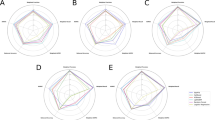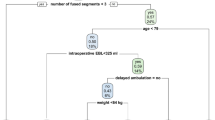Abstract
Purpose
Posterior cervical fusion is associated with increased rates of complications and readmission when compared to anterior fusion. Machine learning (ML) models for risk stratification of patients undergoing posterior cervical fusion remain limited. We aim to develop a novel ensemble ML algorithm for prediction of major perioperative complications and readmission after posterior cervical fusion and identify factors important to model performance.
Methods
This is a retrospective cohort study of adults who underwent posterior cervical fusion at non-federal California hospitals between 2015 and 2017. The primary outcome was readmission or major complication. We developed an ensemble model predicting complication risk using an automated ML framework. We compared performance with standard ML models and logistic regression (LR), ranking contribution of included variables to model performance.
Results
Of the included 6822 patients, 18.8% suffered a major complication or readmission. The ensemble model demonstrated slightly superior predictive performance compared to LR and standard ML models. The most important features to performance include sex, malignancy, pneumonia, stroke, and teaching hospital status. Seven of the ten most important features for the ensemble model were markedly less important for LR.
Conclusion
We report an ensemble ML model for prediction of major complications and readmission after posterior cervical fusion with a modest risk prediction advantage compared to LR and benchmark ML models. Notably, the features most important to the ensemble are markedly different from those for LR, suggesting that advanced ML methods may identify novel prognostic factors for adverse outcomes after posterior cervical fusion.



Similar content being viewed by others
References
Veeravagu A, Connolly I, Lamsam L et al (2016) Surgical outcomes of cervical spondylotic myelopathy: an analysis of a national, administrative, longitudinal database. Neurosurg Focus 40(6):E11
Fehlings M, Wilson J, Kopjar B et al (2013) Efficacy and safety of surgical decompression in patients with cervical spondylotic myelopathy: results of the AOSpine North America prospective multi-center study. J Bone Jt Surg Am 95(18):1651–1658
Goz V, Weinreb J, McCarthy I, Schwab F, Lafage V, Errico T (2013) Perioperative complications and mortality after spinal fusions: analysis of trends and risk factors. Spine 38(22):1970–1976
Memtsoudis S, Hughes A, Ma Y, Chiu Y, Sama A, Girardi F (2011) Increased in-hospital complications after primary posterior versus primary anterior cervical fusion. Clin Orthop Relat Res 469:649–657
Shamji M, Cook C, Pietrobon R, Tackett S, Brown C, Isaacs R (2009) Impact of surgical approach on complications and resource utilization of cervical spine fusion: a nationwide perspective to the surgical treatment of diffuse cervical spondylosis. Spine J 9(1):31–38
Alaa A, van der Schaar M [2018] AutoPrognosis: automated clinical prognostic modeling via Bayesian optimization with structured kernel learning. Proc 35th Int Conf Mach Learn PMLR, 80:139–148.
Alaa AM, Bolton T, Di AE, Rudd JHF, van der Schaar M (2019) Cardiovascular disease risk prediction using automated machine learning: a prospective study of 423,604 UK biobank participants. PLoS One 14(5):1–17
Alaa AM, van der Schaar M (2018) Prognostication and risk factors for cystic fibrosis via automated machine learning. Sci Rep 8(1):1–19. https://doi.org/10.1038/s41598-018-29523-2
Shah AA, Devana SK, Lee C, Kianian R, van der Schaar M, SooHoo NF (2021) Development of a novel, potentially universal machine learning algorithm for prediction of complications after total hip arthroplasty. J Arthroplast 36(5):1655–1662
Yale New Haven Health Services Corporation/Center for Outcomes Research & Evaluation. 2017 Procedure-specific measure updates and specifications report hospital-level risk-standardized complication measure: elective primary total hip arthroplasty (THA) and/or total knee arthroplasty (TKA) - version 6.0. 2017.
Breiman L (2001) Random forests. Mach Learn 45:5–32
Ratsch G, Onoda T, Muller K (2001) Soft margins for AdaBoost. Mach Learn 42:287–320
Friedman JH (2001) Greedy function approximation: a gradient boosting machine. Ann Stat 29(5):1189–1232. https://doi.org/10.1214/aos/1013203451
Chen T, Guestrin C [2016] XGBoost: a scalable tree boosting system. KDD ’16 Proc 22nd ACM SIGKDD Int Conf Knowl Discov Data Min 785–794.
Pedregosa F, Varoquaux G, Gramfort A et al (2011) Scikit-learn: machine learning in Python. J Mach Learn Res 12(85):2825–2830
Manning DW, Edelstein AI, Alvi HM (2016) Risk prediction tools for hip and knee arthroplasty. J Am Acad Orthop Surg 24(1):19–27. https://doi.org/10.5435/JAAOS-D-15-00072
Choy W, Lam S, Smith Z, Dahdaleh N (2018) Predictors of 30-day hospital readmission after posterior cervical fusion in 3401 patients. Spine 43(5):356–363
DePasse J, Durand W, Eltorai A, Palumbo M, Daniels A (2018) Timing of complications following posterior cervical fusion. J Orthop 15(2):522–526
Vonck C, Tanenbaum J, Bomberger T et al (2018) Short-term outcomes following posterior cervical fusion among octogenarians with cervical spondylotic myelopathy: a NSQIP database analysis. Spine J 18(9):1603–1611
Katz A, Mancini N, Karukonda T, Cote M, Moss I (2019) Comparative and predictor analysis of 30-day readmission, reoperation, and morbidity in patients undergoing multilevel ACDF versus single and multilevel ACCF using the ACS-NSQIP dataset. Spine 44(23):E1379–E1387
Wu C, Chen Y, Wang M, Pinelis E (2017) National trends in admission for aspiration pneumonia in the United States, 2002–2012. Ann Am Thorac Soc 14(6):874–879
Radcliff K, Ong K, Lovald S, Lau E, Kurd M (2017) Cervical spine surgery complications and risks in the elderly. Spine 42(6):E347–E354
Al-Taki M, Sukkarieh H, Hoballah J et al (2018) Effect of gender on postoperative morbidity and mortality outcomes: a retrospective cohort study. Am Surg 84(3):377–386
Lee N, Kothari P, Kim C et al (2018) The impact of resident involvement in elective posterior cervical fusion. Spine 43(5):316–323
Gianfrancesco M, Tamang S, Yazdany J, Schmajuk G (2018) Potential biases in machine learning algorithms using electronic health record data. JAMA Intern Med 178(11):1544–1547
Funding
The research reported in this publication was supported by the National Institute of Arthritis and Musculoskeletal and Skin Diseases of the National Institutes of Health under the Ruth L. Kirschstein National Research Service Award Number T32AR059033.
Author information
Authors and Affiliations
Corresponding author
Ethics declarations
Conflict of interest
The authors declare they have no relevant financial interests.
Code availability
The code can be made available from the corresponding author on reasonable request.
Additional information
Publisher's Note
Springer Nature remains neutral with regard to jurisdictional claims in published maps and institutional affiliations.
Supplementary Information
Below is the link to the electronic supplementary material.
Rights and permissions
About this article
Cite this article
Shah, A.A., Devana, S.K., Lee, C. et al. Machine learning-driven identification of novel patient factors for prediction of major complications after posterior cervical spinal fusion. Eur Spine J 31, 1952–1959 (2022). https://doi.org/10.1007/s00586-021-06961-7
Received:
Revised:
Accepted:
Published:
Issue Date:
DOI: https://doi.org/10.1007/s00586-021-06961-7




